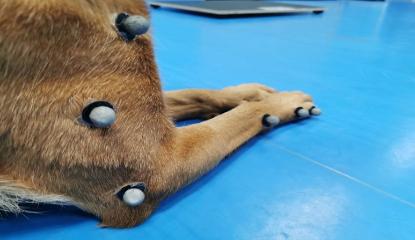
Dr. Natasha Clark, a member of the Department of Musculoskeletal and Ageing Science, has recently completed collecting data on 60 Labrador Retrievers at the specialised Gait Lab situated in the William Henry Duncan Building. The data collection was for the third year of her longitudinally focused PhD project and will provide greater understanding of canine mobility issues.
I have always loved conducting research; I find it exciting to investigate the unknown and potentially have the means to make a difference with my findings. An interest in an academic career was formulated during my undergraduate veterinary degree when I participated in various summer research projects. All the research projects I helped with during my undergraduate degree had one common theme, to improve animal health and welfare.
In September 2020, I started my research masters (MPhil) at the University of Liverpool. My MPhil aimed to validate a newly designed owner-reported mobility questionnaire that aimed to detect subtle changes in a dog’s mobility and highlight any concerns. After my MPhil, I continued my work on to a PhD investigating long-term (longitudinal) changes to a dog’s mobility over 3 years (2022-2025).

To detect changes in a dog’s mobility over 3 years, 60 labrador retrievers (and their owners) were recruited to undergo a veterinary clinical examination, 3D gait analysis and complete the new mobility questionnaire (validated in my MPhil) annually. In both human and veterinary medicine, 3D gait analysis is considered the ‘gold standard’ method of analysing mobility as it can detect minor changes in mobility. To collect 3D gait data, 44 sticky retroreflective markers are attached to various anatomical locations on the dog’s body to detect abnormal joint angles.
The dogs then ‘trot’ over 3 floor-mounted force plates approximately 25 times to gain data related to the forces exerted from each leg. The reflective markers and force plate data are comp together to detect differences in stride lengths/widths/speed and highlight possible lameness.

The project has been positively received by Labrador retriever societies, owners and the wider veterinary community since it aims to enhance the health and welfare of a breed that is at an increased risk of getting mobility problems. I have presented at numerous conferences and published papers focused on my work to increase my understanding of the subtle signs of early canine mobility problems. Furthermore, I recently had the pleasure of welcoming back Kira Leith-Ross from the Labrador Retriever Breed Society and Labrador Breed Council for her 5 labradors to participate in the 3rd year of the study.
More excitingly, my supervisors and I are working to create a canine mobility smartphone app to enhance the health and welfare of dogs. The app will contain the newly validated questionnaire and will be used by owners and vets at annual health checks or vaccinations to monitor the dog’s mobility and prompt any necessary lifestyle and therapeutic interventions for the dog. We also hope the development of the free app will give owners greater insight into their pet’s health and have greater agency when seeing their vet.